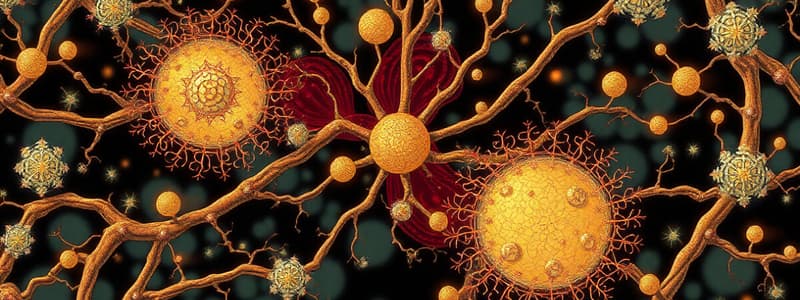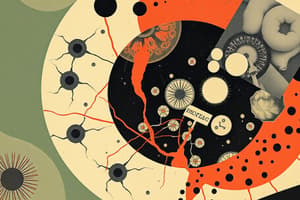Podcast
Questions and Answers
Which of the following cellular components are shared by a red blood cell and a muscle cell? (Select all that apply)
Which of the following cellular components are shared by a red blood cell and a muscle cell? (Select all that apply)
- Cell Wall
- Nucleus (correct)
- Mitochondria (correct)
- Chloroplasts
Which of the following statements is FALSE regarding the levels of biological organization?
Which of the following statements is FALSE regarding the levels of biological organization?
- A human oocyte is larger than a red blood cell and can be viewed using a light microscope.
- Bacteria are generally larger than viruses and can be observed using both light and electron microscopes.
- Viruses are smaller than ribosomes and can only be observed using an electron microscope. (correct)
- Large macromolecules, such as proteins, are generally larger than small molecules, such as amino acids, and are visible using an electron microscope.
Based on the provided information, which of the following could be observed using an electron microscope? (Select all that apply)
Based on the provided information, which of the following could be observed using an electron microscope? (Select all that apply)
- Mitochondria (correct)
- Amino acids (correct)
- Red blood cell
- Human oocyte
A student is observing a sample under a microscope and notices a structure that is approximately 10 µm in size. Which of the following could the student be observing?
A student is observing a sample under a microscope and notices a structure that is approximately 10 µm in size. Which of the following could the student be observing?
Why is it important that stem cells can differentiate into any cell in the body?
Why is it important that stem cells can differentiate into any cell in the body?
Which of the following is NOT a function of glial cells?
Which of the following is NOT a function of glial cells?
Which type of synapse connects a neuron to a skeletal muscle?
Which type of synapse connects a neuron to a skeletal muscle?
What structure within a neuron receives electrical input?
What structure within a neuron receives electrical input?
Which of the following is NOT a characteristic of cardiac muscle tissue?
Which of the following is NOT a characteristic of cardiac muscle tissue?
Which of the following is the main function of the central nervous system (CNS)?
Which of the following is the main function of the central nervous system (CNS)?
What is the role of the myelin sheath in the nervous system?
What is the role of the myelin sheath in the nervous system?
Which type of glial cell is responsible for providing electrical insulation for axons?
Which type of glial cell is responsible for providing electrical insulation for axons?
Which of the following statements accurately describes a neuroglandular synapse?
Which of the following statements accurately describes a neuroglandular synapse?
Which of the following is NOT a component of a typical neuron?
Which of the following is NOT a component of a typical neuron?
Which of the following would be considered an example of 'applied anatomy'?
Which of the following would be considered an example of 'applied anatomy'?
In a seated position, raising your arm above your head could be described as a combination of which movements?
In a seated position, raising your arm above your head could be described as a combination of which movements?
Which of the following best describes the role of the 'basement membrane' in the body?
Which of the following best describes the role of the 'basement membrane' in the body?
Which of the following pairs of anatomical terms correctly describes the relationship between the knee and the ankle?
Which of the following pairs of anatomical terms correctly describes the relationship between the knee and the ankle?
Based on the provided anatomical terminology, which of the following would be the most appropriate technique for studying the electrical activity of nerve cells?
Based on the provided anatomical terminology, which of the following would be the most appropriate technique for studying the electrical activity of nerve cells?
Which of the following scenarios would be best described using the term 'innervation'?
Which of the following scenarios would be best described using the term 'innervation'?
Which of the following terms accurately reflects the relationship between the heart and the lungs?
Which of the following terms accurately reflects the relationship between the heart and the lungs?
What happens to the overall thickness of the epiphyseal plate as new bone is added on the diaphyseal side?
What happens to the overall thickness of the epiphyseal plate as new bone is added on the diaphyseal side?
What is the primary mechanism for bone growth in length, and where does it occur?
What is the primary mechanism for bone growth in length, and where does it occur?
Which of the following bone surface markings is characterized by a large, rounded, roughened projection?
Which of the following bone surface markings is characterized by a large, rounded, roughened projection?
A fracture to the epiphyseal plate can lead to what outcome?
A fracture to the epiphyseal plate can lead to what outcome?
Where does appositional growth occur in a bone?
Where does appositional growth occur in a bone?
What is the functional classification of a joint that allows for a wide range of motion?
What is the functional classification of a joint that allows for a wide range of motion?
Which of the following is NOT a type of bone surface marking?
Which of the following is NOT a type of bone surface marking?
Which of the following statements accurately describes bone growth in diameter?
Which of the following statements accurately describes bone growth in diameter?
Flashcards
Biological organization levels
Biological organization levels
Different scales of biological structure ranging from atoms to humans.
Stem cells
Stem cells
Cells that can differentiate into any cell type in the body.
Light microscope
Light microscope
An optical instrument used to observe small specimens like cells.
Electron microscope
Electron microscope
Signup and view all the flashcards
Micron (μm)
Micron (μm)
Signup and view all the flashcards
Anatomy
Anatomy
Signup and view all the flashcards
Physiology
Physiology
Signup and view all the flashcards
Gross Anatomy
Gross Anatomy
Signup and view all the flashcards
Microscopic Anatomy
Microscopic Anatomy
Signup and view all the flashcards
Developmental Anatomy
Developmental Anatomy
Signup and view all the flashcards
Afferent
Afferent
Signup and view all the flashcards
Coronal Plane
Coronal Plane
Signup and view all the flashcards
Cardiac Muscle Tissue
Cardiac Muscle Tissue
Signup and view all the flashcards
Intercalated Discs
Intercalated Discs
Signup and view all the flashcards
Nervous Tissue
Nervous Tissue
Signup and view all the flashcards
Neurons
Neurons
Signup and view all the flashcards
Glial Cells
Glial Cells
Signup and view all the flashcards
Dendrites
Dendrites
Signup and view all the flashcards
Axon
Axon
Signup and view all the flashcards
Central Nervous System (CNS)
Central Nervous System (CNS)
Signup and view all the flashcards
Peripheral Nervous System (PNS)
Peripheral Nervous System (PNS)
Signup and view all the flashcards
Epiphyseal plate
Epiphyseal plate
Signup and view all the flashcards
Interstitial growth
Interstitial growth
Signup and view all the flashcards
Appositional growth
Appositional growth
Signup and view all the flashcards
Bone surface markings
Bone surface markings
Signup and view all the flashcards
Foramen
Foramen
Signup and view all the flashcards
Fossa
Fossa
Signup and view all the flashcards
Sulcus
Sulcus
Signup and view all the flashcards
Condyle
Condyle
Signup and view all the flashcards
Functional classification of joints
Functional classification of joints
Signup and view all the flashcards
Study Notes
Course Information
- Course title: ANAT7002 - Anatomy & Neuroanatomy Fundamentals for Speech Pathologists
- Lecturer: Dr. Ray Lang
- Lectures are Tuesdays, 4-hour block (3 lectures + 1 revision)
- Workshops are Fridays (AM)
Acknowledgement of Country
- Traditional Owners of the land are acknowledged
- Their ancestors and descendants are recognised
- Cultural and spiritual connections are highlighted
- Ongoing contributions to Australian and global society are valuable
Learning Objectives
- Describe the main anatomical structures of the head, neck, and thorax involved in human communication and swallowing
- Associate anatomical structures and their function to typical communication and swallowing processes
- Explain the role of key sensory and motor systems in typical communication and swallowing processes
- Integrate various anatomical structures and their function of the head, neck, and thorax to predict functional deficits resulting from altered anatomy
Course Structure
- Module 1: Introduction to regional and functional anatomy relevant for speech and swallowing
- Module 2: Functional anatomy of mastication, deglutition, and phonation apparatuses
- Module 3: Sensory systems involved in speech and swallowing
- Module 4: Motor control relevant for speech and swallowing
Course Staff and Contributors
- The course staff, including Dr. Ray Lang, are listed
- There are also additional contributors (listed by name)
Assessment
- In-Workshop Quizzes (50%): 10 multiple-choice questions per quiz, 15 minutes per quiz
- End-of-Semester Exam (50%): 25 multiple-choice questions, 25 short answer questions, 15 minutes reading time, 60 minutes to complete
Recommended Textbooks
- Details for textbooks are provided, including those available via the UQ Library
Course Comments
- Contact details are provided for course-related questions (email, Blackboard discussion board)
Lecture 1: Cells, Tissue Types, and Broad Terminology
- Learning objectives include describing the levels of organization in the human body, cellular composition of tissues/organs, types of cells, how different tissues interact, peripheral/nervous system, and autonomic nervous systems
Levels of Biological Organization
- Various levels are described, from atoms to molecules up to the organismal level
- Size ranges are given for various biological entities
- Visual aids (diagrams) are mentioned to illustrate the scale
Cell Differentiation and Types
- Stem cells can differentiate into numerous cell types
- Cells have similar genetic, metabolic and structural principles across many different types
Sub-Organismal Systems
- The body's organ systems work integratively, and are described and shown in diagrams to explain functioning
Nervous Tissue
- Neurons receive and transmit electrical impulses
- Glial cells provide structural and functional support to neurons
Neuronal Connections (Synapses)
- 3 types—Synapses with other neurons, Neuromuscular, Neuroglandular
- Key component parts are labelled in diagrams
Nervous System Components
- Central Nervous System (CNS) includes the brain and spinal cord—integrates signals and performs higher cognitive functions.
- Peripheral Nervous System (PNS)—the nerves outside the CNS, connects CNS to organs/muscles
PNS: Spinal and Cranial Nerves
- Importance for speech and described in relation to anatomy
Autonomic Nervous System
- Composed of sympathetic ('fight or flight') and parasympathetic ('rest and repose') divisions
- Key examples and functions are given for each system
Bone Tissue
- Two types of bone tissue: compact & cancellous
- Describes cartilage structure including cells and extracellular matrix
- Also describes bone microscopic structure, including cells, and types
Bone Growth
- Endochondral (cartilage-based) and intramembranous (membrane-based) ossification
- The epiphyseal plate is described as a growth plate
- Appositional growth results in an increase in bone diameter
Sutures in the Skull
- Synarthroses (fibrous joints)
- Connecting areas between cranial bones
Fontanelles
- Structures are described as incomplete at birth, and help during passage through the birth canal
Cavities & Sinuses of the Skull
- Major cranium cavities/structures described to include the orbital, nasal and oral cavities, paranasal sinuses
- Diagrams included to identify components.
The Axial Skeleton
- Includes the skull, vertebral column and thoracic cage
- Functions, including protection, supports and attachments, are included
Studying That Suits You
Use AI to generate personalized quizzes and flashcards to suit your learning preferences.




